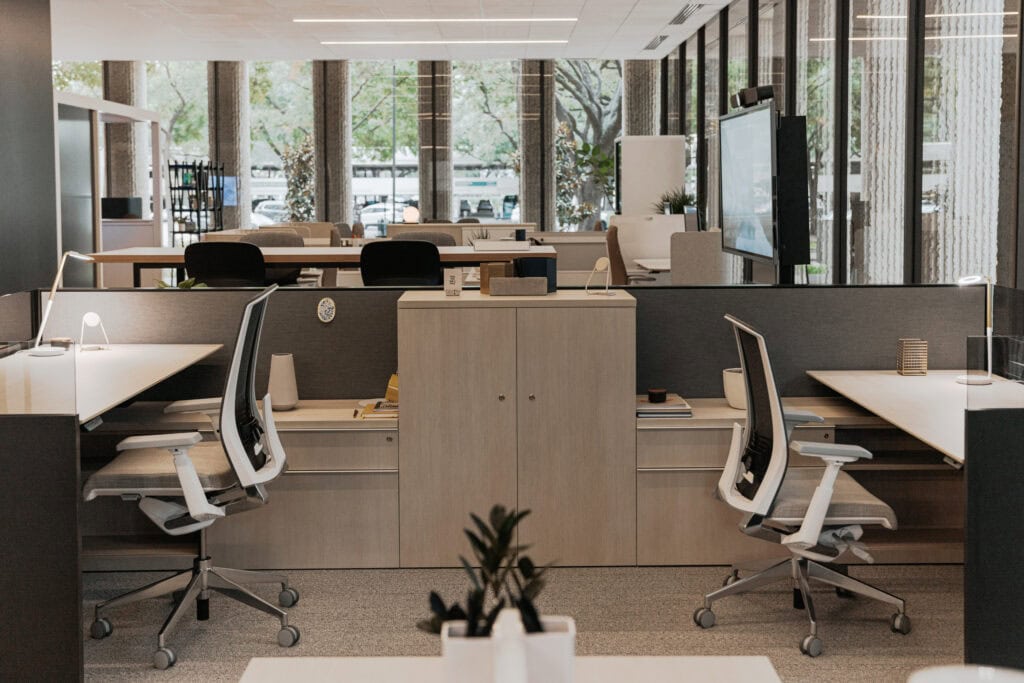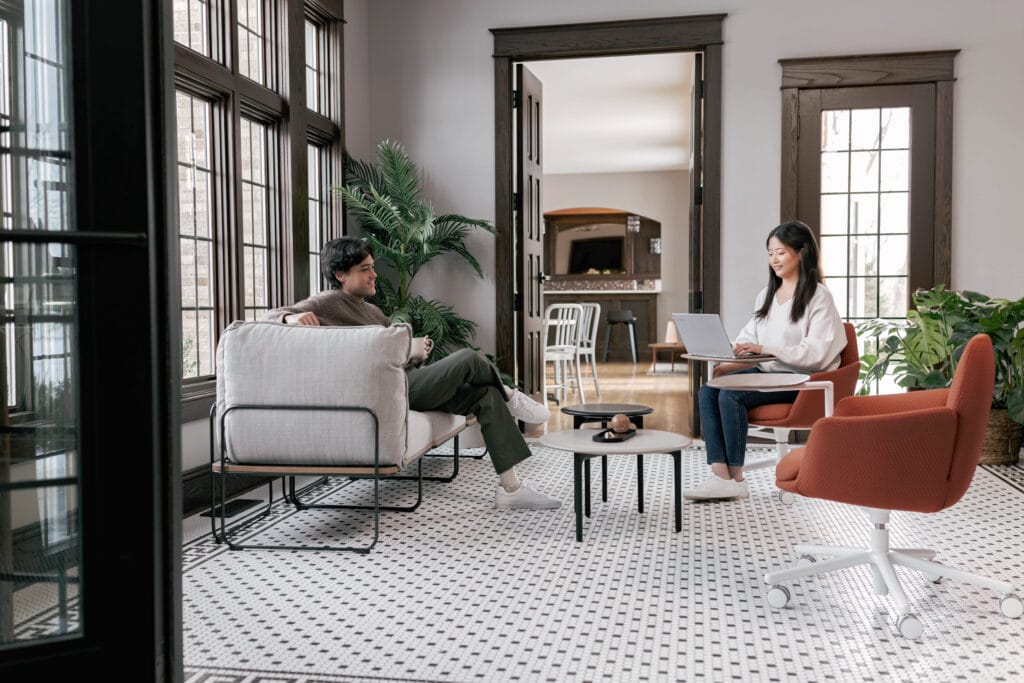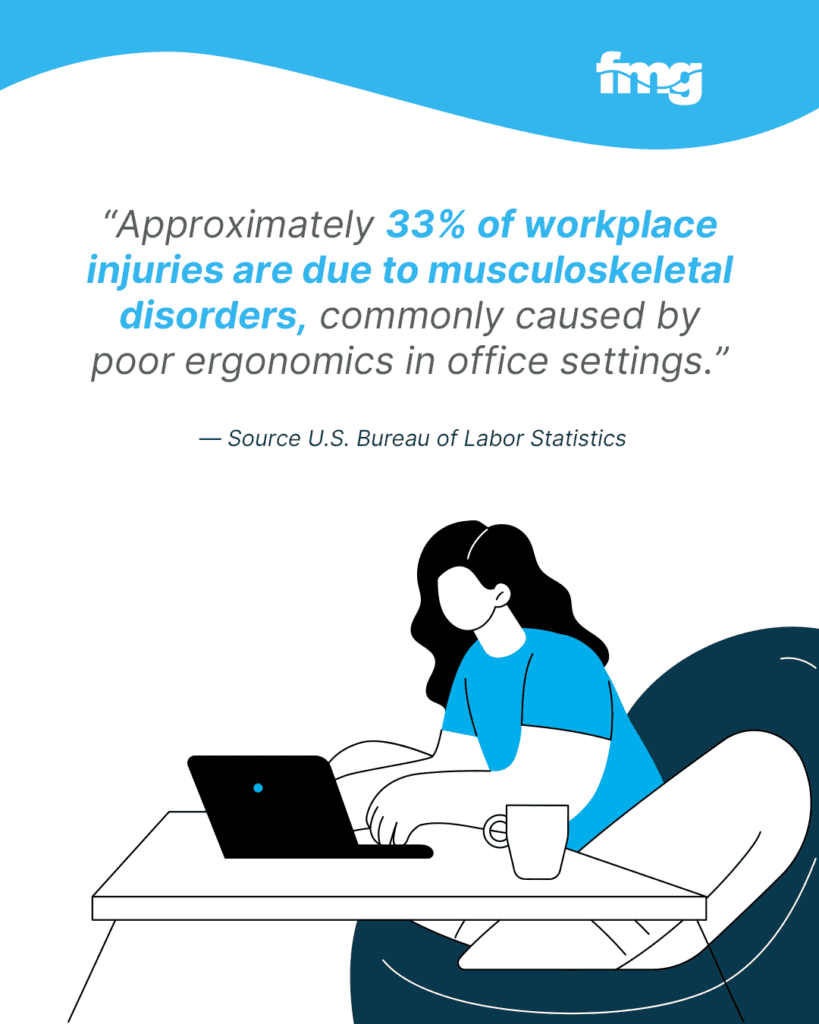In the modern, fast-paced business environment, fostering productivity is imperative, and ergonomic furniture plays a crucial role in achieving this objective. As office managers and HR leaders explore innovative strategies to enhance workplace efficiency, ergonomic office designs present a promising solution.
These designs bolster employee well-being and lay the groundwork for comfortable office solutions that drive productivity improvements. By emphasizing the science of comfort, organizations can enable their teams to excel, allowing them to focus on their tasks without the distraction of physical discomfort.
Key Takeaways
- Ergonomic Designs Boost Productivity: Implementing ergonomic office designs can notably enhance productivity by aligning with natural human movements and reducing physical discomfort.
- Significant Health Benefits: Ergonomic setups like adjustable chairs and desks help prevent musculoskeletal disorders, promoting employees’ physical and mental well-being.
- Customized Workstations Increase Engagement: Personalizing workstations to fit teams’ specific needs improves comfort and satisfaction, leading to increased engagement and productivity.
- Standing Desks Enhance Focus: Integrating standing desks allows employees to choose between sitting and standing, which can boost energy levels and focus.
- Investing in Ergonomics Yields Long-term Benefits: While there may be initial costs, the savings from reduced absenteeism, increased productivity, and improved employee morale can far outweigh the investment, offering substantial advantages over time.

The Role of Ergonomics in Productivity
Ergonomic office designs are centered on creating a workspace that aligns with the natural movements and postures of the human body. This involves selecting furniture and equipment that support physical comfort and reduce strain. Key features of ergonomic designs include adjustable chairs, desks, and monitor arms tailored to individual preferences and needs.
Incorporating ergonomic elements significantly enhances employee well-being, minimizing the risk of repetitive strain injuries and discomfort. Consequently, employees maintain focus and efficiency throughout their workday. Additionally, ergonomic designs often result in a more organized and clutter-free environment, further aiding concentration and productivity.
These designs go beyond aesthetics to offer practical solutions that enable employees to perform their tasks comfortably and effectively. Ergonomic office designs are fundamental to achieving workplace productivity by prioritizing employee health and comfort.
Benefits of Office Comfort Solutions
When employees feel physically at ease, they can concentrate better, improving overall job performance. A comfortable workspace also boosts morale and job satisfaction, making employees feel valued and appreciated. This sense of care enhances loyalty and retention, as employees are likelier to remain with organizations prioritizing their well-being.
Implementing office comfort solutions substantially improves productivity, employee satisfaction, and workplace harmony. These benefits underscore the importance of investing in designs catering to the workforce’s physical and emotional needs.

Impact on Employee Well-being
Ergonomic office designs significantly impact employee well-being, directly influencing physical and mental health. Proper ergonomic setups, such as height-adjustable desks and supportive chairs, help prevent musculoskeletal disorders and reduce discomfort during long work hours. This proactive approach fosters a healthier workforce, minimizing the risk of chronic pain and workplace injuries.

In addition to physical health, ergonomic environments positively affect mental well-being. A well-designed workspace can alleviate stress by promoting movement and flexibility, allowing employees to comfortably shift between sitting and standing positions. This adaptability reduces monotony and can enhance mood, leading to higher job satisfaction and decreased burnout rates.
Ultimately, prioritizing ergonomic solutions demonstrates a commitment to maintaining employee health and happiness. When employees feel cared for, it strengthens their connection to the organization, boosts motivation, and fosters a positive workplace culture, which is crucial for sustained productivity and success.
Choosing the Right Furniture
The right ergonomic furniture is essential for creating a workspace that enhances productivity and employee well-being. The process begins with understanding the specific needs of your workforce, considering factors such as job roles and individual preferences. Chairs with adjustable height, lumbar support, and swivel features are vital for providing comfort and reducing strain.
Desks should accommodate various work styles, offering adjustable heights for both sitting and standing options. Including monitor stands or arms can help position screens at eye level, preventing neck and eye strain. Additionally, accessories like footrests, ergonomic keyboards, and mice can further enhance comfort.
“Implementing ergonomic furniture and solutions in the workplace has been shown to increase productivity by an average of 11%.” — Source Occupational Safety and Health Administration
While investing in quality ergonomic furniture may incur upfront costs, the long-term benefits, including increased productivity, reduced absenteeism, and improved employee satisfaction, far outweigh these expenses. By prioritizing the selection of appropriate furniture, organizations demonstrate a commitment to nurturing a supportive and efficient work environment.

Customizing Workstations for Teams
Customizing workstations to meet the varied needs of teams can significantly boost workplace productivity. Tailoring workstations involves considering the tasks typically performed and adjusting the workspace to support those activities effectively. This personalization may include altering desk heights, configuring storage solutions, and positioning equipment for optimal accessibility.
For teams that require frequent collaboration, incorporating modular furniture that can be easily rearranged encourages interaction and idea-sharing. Conversely, providing privacy panels or noise-canceling solutions for roles demanding concentration can help minimize distractions.
“Workplaces with ergonomic solutions see a 32% reduction in employee sick days, reflecting improved health and reduced workplace injuries.” — Source Human Factors and Ergonomics Society
Offering options for personalization empowers employees to create a workspace that suits their preferences, increasing comfort and satisfaction. This approach enhances efficiency and signals that the organization values individual contributions and needs. As employees feel more connected to their personalized spaces, their engagement and commitment to their work will likely increase, fostering a more dynamic and productive work environment.
Integrating Standing Desks
Standing desks have become popular in ergonomic office setups due to their health and productivity benefits. Integrating standing desks allows employees to alternate between sitting and standing throughout the day, promoting better posture and reducing the risk of sedentary-related health issues.

To maximize the benefits of standing desks, it’s essential to provide adjustable options that cater to various heights and preferences. This flexibility ensures that each employee can maintain a comfortable and ergonomic posture when switching between sitting and standing. Additionally, providing anti-fatigue mats can improve comfort for those who stand for extended periods.
Implementing standing desks can increase energy levels and focus, as the ability to move freely reduces fatigue and enhances circulation. By offering this versatile furniture option, organizations demonstrate a commitment to employee well-being, supporting a more active and engaged workforce.
Design Spaces That Support Ergonomic Health
Are you looking to transform your office into a dynamic, ergonomic workspace that promotes well-being, productivity, and team collaboration? With our expertise in ergonomic design, innovative solutions, and advanced workplace technology, we can create a space that supports your team’s health and enhances performance.
Connect with us today to start building a workspace where comfort meets productivity. Let’s create an environment that empowers your team to thrive, with spaces designed to support their health, focus, and overall well-being. Let’s shape the future of work, one ergonomic solution at a time.

About FMG
FMG designs, specifies and delivers comprehensive workplace solutions. As a “Best In Class Dealer,” FMG has a strategic partnership with Haworth Inc., a global leader in the design and manufacturing of commercial office furniture that includes movable walls, systems furniture, seating, storage, and more.
FMG’s commitment goes beyond providing world-class furniture and architectural products. The very essence of our company is founded on values that place our clients at the heart of everything we do, treating them like family and building trust through exceptional service.


